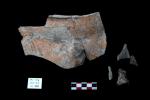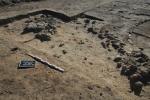Summary (English)
A sondage was opened in the area south of the large floor dating to the 8th (PV2) and late 8th-early 7th (PV1) (fig. 1) in order to check its function and date. As was to be expected, the underlying space showed anthropic activity. A pit (US 4000) had been created exactly below it and contained burnt bone fragments and a wall sherd with a horizontal handle from a bi-conical urn decorated with incised triangles (fig. 2). This important evidence, dating to between the late 9th and the first half of the 8th century B.C., confirmed the existence of an earlier occupation phase on the hill.
Further north, exploration continued in the area adjacent the apsidal building, and also in the space in which there was a deposition of pottery at the centre of the apse. In the area east of the building, excavation of pit US 340 opposite the entrance, and of the area next to it, continued (fig. 1). The pit was filled with extremely compact red earth, containing very few pottery fragments, among which a figured wall sherd of transitional proto-Corinthian. This dates the obliterating fill (exactly like all the others excavated so far) to between the late 7th and early 6th century B.C., that is the moment the site was abandoned. The extension of the excavation around the pit revealed a series of surfaces created using minute cobblestones embedded directly in the earth, which surrounded the pit’s north and south edges (fig. 3). Considering the chthonic nature of the ritual practices attested inside the apsidal building, there is a strong temptation to interpret this structure as a bothros.
The other important discovery made this season was a structure made of large stone blocks, on an east-west alignment, situated in the area immediately north of the apsidal building (fig. 4). The structure (US 381) presented a well-preserved row of blocks on the north side, while it appeared incomplete on the south side, and was preserved to a width of just under 2 m. The best-preserved blocks lay horizontally, directly embedded in a layer of earth without a foundation trench. Along the south side, there was a fired-brick feature incorporated within the structure, formed by three horizontal bricks, bordered by others that were thinner and fixed vertically to form a border, perhaps constituting a small channel?
A brick wall probably stood on top of structure US 381, as there was a substantial collapse of large bricks (US 412, fig. 4) about 2 m to the south, lying longitudinally and perfectly parallel to it. Considering the presence of the substantial stone structure that recently came to light along the western edge of the excavation area (fig. 1, “west structure”), the existence of a large wall (defensive?) may be suggested that would have extended along the north-western edge of the Incoronata hill. According to this hypothesis what remains in situ are the foundations while the brick collapse excavated this year (US 412) and the hundreds of brick fragments thrown into the obliteration layers attest the actual walls. However, for the moment this is only a working hypothesis.
- Mario Denti - Laboratoire LAHM, UMR 6566 CReAAH, Université de Rennes 2
Director
Team
- Clément Bellamy- Laboratoire LAHM, UMR 6566 CReAAH, Université Rennes 2
- Emmanuelle Smirou- Laboratoire LAHM, UMR 6566 CReAAH, Université Rennes 2
- François Meadeb- Laboratoire LAHM, UMR 6566 CReAAH, Université Rennes 2
- Mathilde Villette-Laboratoire LAHM, UMR 6566 CReAAH, Université Rennes 2
Research Body
- Laboratoire LAHM, UMR 6566 CReAAH, Université Rennes 2
Funding Body
- Laboratoire LAHM - Université Rennes 2






![Download [PDF]](/excavation/skins/fasti/images/results/download_sml.png)


